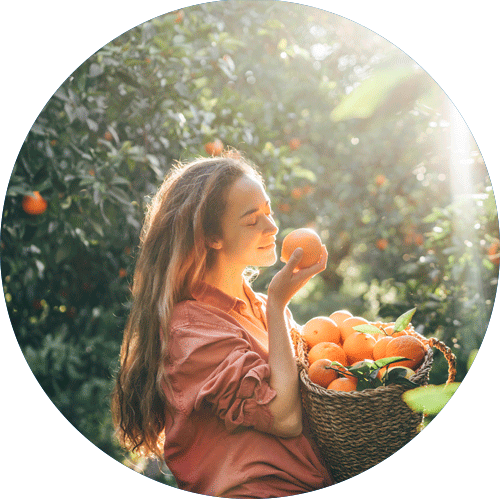Consumers’ scent preferences go beyond personal taste—they reflect the most subtle and emotional expressions of their cultural history. The scent profiles that captivate consumers in different regions of the world are deeply connected to their culture, art, food, and heritage. In other words, we smell with our memory, and that memory is steeped in the land where we are born or where we live.
A culturally coded sensory system
The sense of smell is an exceptional channel for activating memories and emotions. But what each culture associates with something “pleasant,” “refreshing,” “sophisticated,” or “comforting” varies greatly depending on its heritage. The same is true for flavor preferences. The tastes we enjoy are the product of centuries of local cuisine, shared rituals, and the flora and ingredients available in each place. It’s no surprise that these flavor preferences also influence the fragrances we choose for our bodies, our homes, and our everyday products.
Cultural resonance in action
Japan: The elegance of the ethereal
Both in its cuisine and olfactory traditions, Japan values light, fresh, and watery nuances. Bamboo, green tea, and cherry blossom notes resonate with the wabi-sabi aesthetic and the subtlety of the country’s flavors.
Arab countries: Opulence and sensuality
A love of intense, spicy, and sweet flavors—like dates, cardamom, and saffron—is mirrored in their affinity for deep fragrances such as oud, amber, and rose.
Brazil: Energy and exuberance
The Brazilian palate is drawn to juicy, vibrant tropical fruits. In perfumery, fruity, floral, and gourmand families are very well received, evoking the country’s festive and sensorial spirit.
France: Sophistication and savoir-faire
France’s culinary and artistic culture has cultivated an affinity for complex fragrance compositions, with a high regard for harmony between citrus, florals, and fine woods.
Latin America (Andes, Caribbean, Southern Cone): A mosaic
Here, we find strong ties between the use of native ingredients (corn, cacao, vanilla, local fruits, aromatic herbs) and fragrances that highlight nature, authenticity, and a connection to the land.
Implications for fragrance creation
Understanding these connections is key to designing culturally resonant fragrances. It’s not just about following global trends, but understanding the “emotional aroma” that each culture seeks and values. In a world where consumers are increasingly proud of their local identities, fragrances that speak to deep cultural imagery have greater potential to create lasting bonds.
A never-ending sensory journey
Scent preferences, flavor preferences, and cultural heritage form a dynamic triangle. Through marketing, we can explore, honor, and enrich this invisible emotional map, creating sensory experiences that connect with memory, emotion, and pleasure—all within the context of each consumer’s world.
Latin America: The emotional map of a diverse continent
If there’s one region where the triangle of scent preferences, taste preferences, and cultural heritage truly comes alive, it’s Latin America.
This continent exists in a unique balance between tradition and innovation, local pride and cosmopolitanism, lush nature and ancestral memory.
Latin American consumers, while exposed to global trends, are increasingly seeking out fragrances that connect with their history, identity, and everyday sensory references. And that “cultural scent” is anything but uniform—it varies widely by country, region, and even subculture.
Brazil: Tropical exuberance and sensory hedonism
Brazil is arguably the most vibrant and sophisticated fragrance market in Latin America. Here, the celebration of the body, sensuality, and pleasure is experienced intensely. This is evident both in the country’s cuisine and scent preferences:
Dominant flavors: Juicy tropical fruits (passion fruit, mango, açaí, guaraná), coconut, vanilla, sugarcane, warm spices.
Favorite scent profiles: Bold fruity notes, sunlit florals, creamy gourmands, fresh and aquatic accords for the body. Colognes and body splashes are essential to daily routines—freshness + sensuality is the core code.
Key notes: Copaiba wood, cumaru, pitanga. Local ingredients are often reinterpreted in a modern way.
In Brazil, consumers seek fragrances that make them feel energized, sensual, and vibrant—echoing the rhythm of tropical life and the country’s mixed cultural heritage.
Chile: Understated sophistication and a connection to nature
Chile has an extremely interesting scent profile that is somewhat more restrained than its neighbors.
Chilean consumers are historically more reserved, appreciating cleanliness, subtle elegance, and connections with nature. The country’s culinary culture—rich in produce from both the land and sea—has shaped a palate that favors nuance over excess.
Dominant flavors: Fresh fruits (apple, pear, grapes, berries), aromatic herbs, citrus and marine notes, infusions, wine.
Favorite scent profiles: Fresh citrus, soft herbs, clean florals, light woods, aquatic accords. Strong acceptance of fragrances that evoke “open air,” “purity,” and “calm.”
Key notes: Boldo, laurel, maqui, peumo, Elqui Valley lavender. There is growing interest in native ingredients.
In Chile, fragrance is seen as a complement to hygiene, personal wellbeing, and natural elegance—not an aggressive statement. There’s also a strong openness toward wellness trends and sustainability values.
Peru: A blend of traditions and rediscovery of identity
Peru is currently experiencing a cultural renaissance, and that’s reflected in its scent preferences.
Peruvian cuisine—now celebrated worldwide—is a perfect example of this: it is shaped by diverse influences, colorful, rich in native ingredients, and deeply respectful of the land.
Dominant flavors: Andean fruits (lucuma, cherimoya, passion fruit), cacao, purple corn, aromatic herbs, chili peppers, flowers like hibiscus.
Favorite scent profiles: Exotic fruits, sophisticated gourmands (vanilla, cacao), vibrant florals, green and herbal accords that evoke the mountains and rainforest.
Key notes: Andean mint, coca leaf, lemon verbena, palo santo, Andean flowers. Ingredients that reflect the Andean worldview.
Today, Peruvian consumers appreciate products that celebrate their local heritage with a contemporary language. There is strong pride in native ingredients and a desire for fragrances that express nature, authenticity, and emotion.
Understanding these cultural resonances is key to creating relevant and authentic fragrance formulas. Each Latin American consumer, from their own unique perspective, seeks scents that speak their emotional language:
Brazil celebrates vitality.
Chile seeks harmony.
Peru is rediscovering its roots.
The creative challenge lies in translating that invisible sensory map into fragrance pyramids that resonate with the heart of each culture.
You can also find us on






